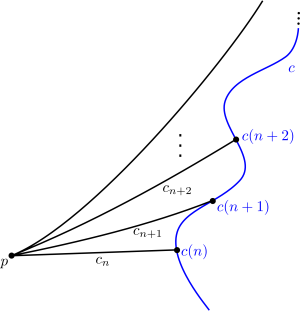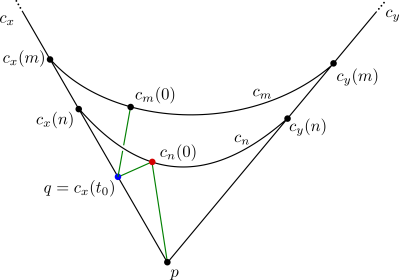In this post and the next, we will discuss Cannon-Thurston maps: (continuous) extensions of inclusions of hyperbolic groups to the boundaries
. It is not evident that such maps should exist when
is distorted in
, but they often do nonetheless. This post will focus on defining the boundary of a hyperbolic group and establishing basic properties. We’ll take a brief look at Cannon-Thurston‘s first (distorted) example. The next post will discuss the progress of Mitra towards the following open question:
Question: If are hyperbolic groups, does there exist a Cannon-Thurston map
?
In particular, he has answered the question in the affirmative for the case of normal hyperbolic subgroups of hyperbolic groups and vertex subgroups of finite hyperbolic graphs of hyperbolic groups with quasi-isometric edge inclusion maps.
1. The boundary of a Gromov-hyperbolic space
In this section, is a geodesic space that is proper and hyperbolic. We’ll see several equivalent definitions for
and the closure
. References include the textbooks of Bridson-Haefliger and Ghys-de la Harpe (in French) and Kapovich-Benakli’s survey paper Boundaries of Hyperbolic Groups.
Here are two examples to keep in mind. Morally, the boundary of the hyperbolic plane should be the circle at infinity in the Poincare disk model. The boundary of the Cayley graph for
should be a Cantor set, which can be viewed (under the “obvious” embedding of the Cantor set in the plane – see picture below) as the set of limit points of
not in
itself. Note: the Cantor set is totally disconnected, so the set of ends is the same as the boundary.

Geodesic rays will be parametrized by arclength.
- Fix a basepoint
. Then
is the set of equivalence classes of geodesic rays
originating at
(i.e.,
). Ray
is equivalent to
, written
, if
, or equivalently if the images of
and
are a finite Hausdorff distance from each other. [Note: for CAT(0) spaces, each equivalence class contains a single ray since the metric is convex.]
-
is defined the same way, but without requiring that rays originate at
.
-
is the set of equivalence classes of quasigeodesic rays (originating at any point in the space). Here we must use only the finite Hausdorff distance as the equivalence relation. [Note: this definition has no analogue for CAT(0) spaces, where there is no quasigeodesic stability.]
These three sets are in natural bijection: As equivalence classes in (1) are contained in equivalence classes in (2) which are contained in equivalence classes in (3), we need only check that each quasigeodesic equivalence class contains a geodesic ray starting at . This follows from the Arzelà–Ascoli theorem and quasigeodesic stability. (Take a sequence
of generalized geodesic rays representing the points
, i.e. geodesic segments connecting the basepoint
to
with domain extended to
by the constant map at
So
A subsequence converges to a geodesic ray from
which is Hausdorff-close to
. See the illustration below.)

To topologize these boundaries, it suffices to topologize . We do this by defining convergence:
as
for
if they are represented by generalized rays (geodesic rays allowed)
from
such that every subsequence of
has itself a subsequence converging to
pointwise and uniformly on compact sets. It is necessary to take subsequences here because we want the sequence of blue points below with red basepoint to converge (to a single point on the boundary):

Closed sets are defined to be the sets containing all their limit points. For any fixed , a fundamental system of open sets in
about
is the collection of
, where a generalized ray
if
. (The choice of
does not matter since asymptotic rays from a fixed basepoint in a hyperbolic space are uniformly close: within
of each other.)
- This difficulty requiring us to take subsequences does not arise in defining the boundary of CAT(0) spaces, since the metric is convex. If
is both hyperbolic and CAT(0), the various
defined above are homeomorphic to the inverse limit of the closed balls
as
varies, induced by the projection maps to these complete convex subsets. The topology is the inverse limit topology (the coarsest topology making all the maps
continuous).
- Let
denote the set of continuous functions from
to
with the compact-open topology. Identify
with a subset of
, where
if
is a constant map, by associating to
the equivalence class of the distance to
function:
. The point of
associated to a geodesic ray
is represented by the Busemann function
defined as
The level sets of Busemann fuctions are called horospheres, agreeing in
with the classical horospheres. A Busemann function can be viewed as a sort of “distance” function to a point of
, but with close points having very small distance: near
instead of near 0.
- Points of the sequential boundary
are represented by sequences in
that converge to a point in
. To describe this convergence, we’ll need to use the Gromov product for points
:
In a tree, the Gromov product represents the overlap length of the segments
and
, or equivalently the distance from
to
. In a
-hyperbolic space, the Gromov product gives a good proxy for
(to within some fixed multiple of
, depending on the definition of
-hyperbolicity used.)
Fix a basepoint
. A sequence
is said to converge at infinity if
as
, and two such sequences
converge to the same point if
. (Transitivity of this relation follows from one of the many equivalent definitions of
-hyperbolicity:
for all
.) A fundamental system of neighborhoods of a boundary point is given by bounding the Gromov overlap from below by a sequence of numbers approaching infinity.
2. Basic Properties
Most of these facts are taken from Bridson-Haefliger, chapter III.H.3.
Fact: is compact. Arzelà–Ascoli gives sequential compactness, and compactness then follows from first countability.
Fact: is visible: for every
,
, there is a geodesic
with
,
. Indeed, take geodesic rays
originating from a basepoint
with
. Since
, there is a point
(shown in blue) a distance more than
away from
. For
, we can choose geodesic segments
joining
to
, and extend them to generalized geodesic lines. By
-hyperbolicity, some point of the segment
is a distance less than
from
, which we can assume is
(shown in red). Then Arzelà–Ascoli gives a subsequence of
converging to a bi-infinite geodesic
. By
-hyperbolicity,
is within
of
for
and within
of
for
. (See the diagram below.) So
and
.

Given a map between hyperbolic spaces, there is at most one way to extend it continuously to the boundary
.
Fact: If is a quasi-isometric embedding of geodesic, proper, hyperbolic spaces then
is a (continuous) embedding, where
(using the quasigeodesic model
of hyperbolic boundary.) If
is a quasi-isometry, then
is a homeomorphism. (These statements follow immediately from quasigeodesic stability and the description of a fundamental base of neighborhoods
above.)
Example: , so
is not quasi-isometric to
unless
.
Since the hyperbolic boundary is a quasi-isometry invariant, we can associate a boundary to a hyperbolic group
.
Example: If is a closed hyperbolic surface and
a closed hyperbolic 3-manifold, then
and
.
Example: is a Cantor set.
By the above fact, the inclusion map from an undistorted hyperbolic subgroup of a hyperbolic group
extends to a continuous map (in fact, an embedding)
. When
is an arbitrary hyperbolic subgroup of a hyperbolic group
, a continuous (not necessarily injective) extension of the inclusion to
is called a Cannon-Thurston map.
3. Cannon and Thurston’s Example
Thurston proved that the mapping torus of a hyperbolic surface
by a surface automorphism
is a hyperbolic 3-manifold if and only if
is pseudo-Anosov. In particular, there exist hyperbolic 3-manifolds where
is an HNN-extension of a surface group
, with
Cannon-Thurston showed the inclusion extends to a surjective map , a space-filling curve. Therefore
is a distorted subgroup of
. This was the first example found of a Cannon-Thurston map involving a distorted subgroup. (Mitra’s work, described in the next post, generalizes this result: he shows that there is a Cannon-Thurston map for any hyperbolic normal subgroup of a hyperbolic group.) We will sketch here why the map is surjective.
acts properly by isometries on
via its inclusion in
. The image of the Cannon-Thurston map is the limit set
: the set of accumulation points in
of any
-orbit in
Since
is a normal subgroup, elements of
act on
by permuting these orbits, so they fix
. Consequently, they fix the convex hull
of
in
. Therefore
contains a
-orbit which is quasi-isometric to
itself, so the closed set
contains the whole boundary
. But
(The interior of a ball together with some points on its boundary is alway convex, after all.) So
.
Kapovich and Short give a generalization of this argument to normal subgroups of -hyperbolic groups.

We answered this question in the negative in a paper “Cannon-Thurston maps do not always exist”:
http://journals.cambridge.org/action/displayAbstract?fromPage=online&aid=9005280&fulltextType=RA&fileId=S2050509413000042